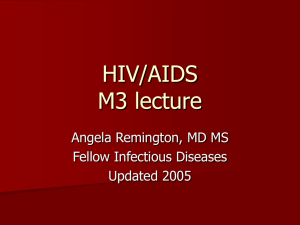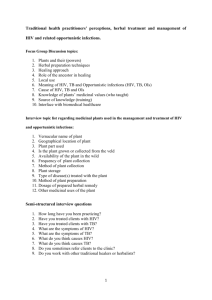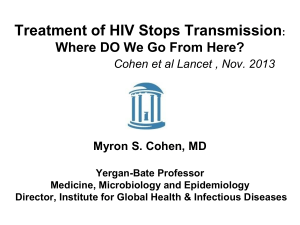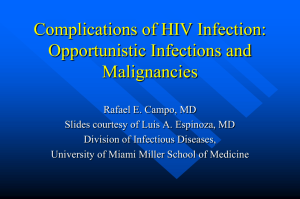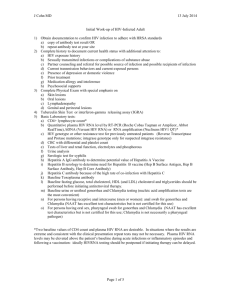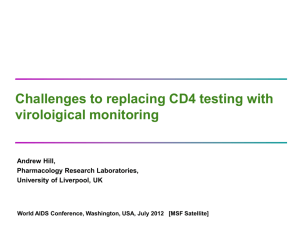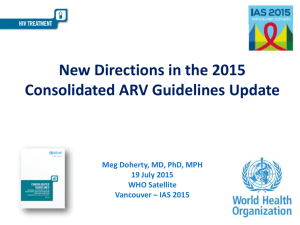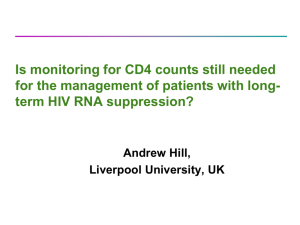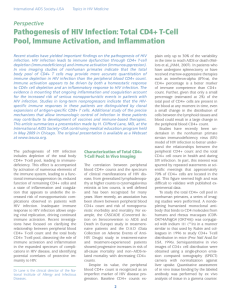infectious disease template
advertisement
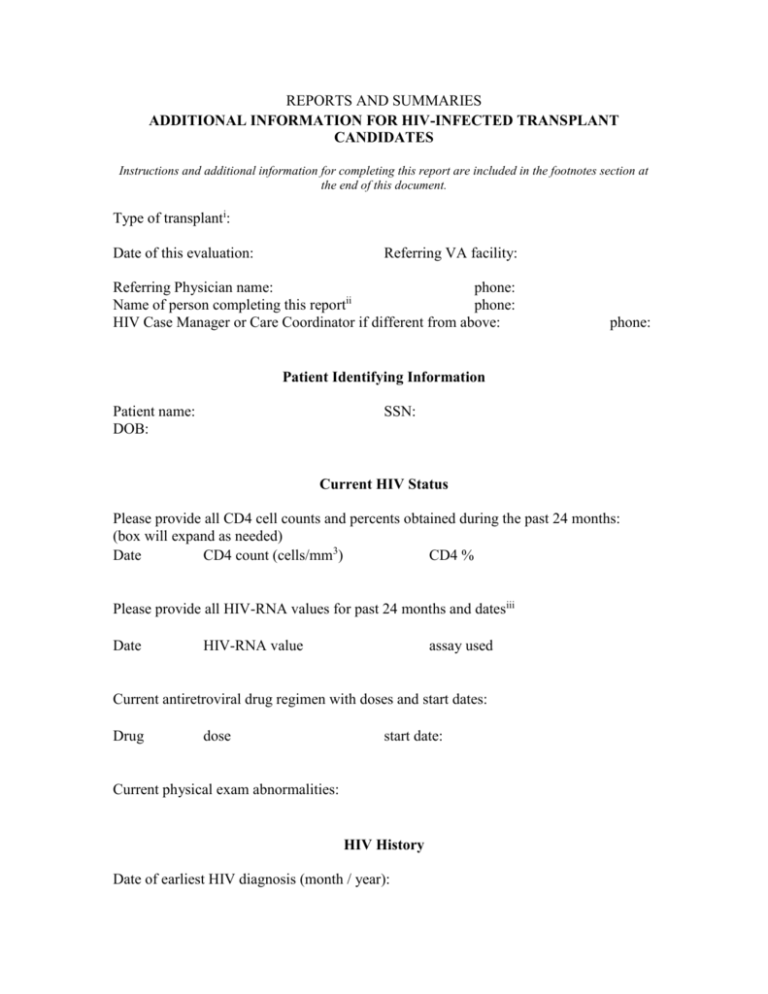
REPORTS AND SUMMARIES ADDITIONAL INFORMATION FOR HIV-INFECTED TRANSPLANT CANDIDATES Instructions and additional information for completing this report are included in the footnotes section at the end of this document. Type of transplanti: Date of this evaluation: Referring VA facility: Referring Physician name: phone: Name of person completing this reportii phone: HIV Case Manager or Care Coordinator if different from above: phone: Patient Identifying Information Patient name: DOB: SSN: Current HIV Status Please provide all CD4 cell counts and percents obtained during the past 24 months: (box will expand as needed) Date CD4 count (cells/mm3) CD4 % Please provide all HIV-RNA values for past 24 months and datesiii Date HIV-RNA value assay used Current antiretroviral drug regimen with doses and start dates: Drug dose start date: Current physical exam abnormalities: HIV History Date of earliest HIV diagnosis (month / year): Nadir (lowest) CD4 cell count: Nadir (lowest) CD4 percent cells/mm3 % Date (month/year): Date (month/year): Please list all AIDS defining conditions and date of earliest occurrence. Please list all antiretroviral drugs received in the past and/or currently with stop and start dates. If a drug was discontinued due to adverse reaction, please identify. Please provide copies of all genotype and/or phenotype results: Questions and Recommendations Based on your knowledge of the patient, examination of refill records, and patient selfreport, do you believe the patient can adhere to a complex regimen of antiretrovirals and immunosuppressive therapy? iv Yes No Based on prior treatment history, potential drug interactions, and available HIV resistance test results, do you believe the patient can receive a post-transplant HAART regimen that will result in durable suppression of HIV replication to undetectable levels? Yes No Base on your assessment of the patient, do you believe that his or her HIV status permits consideration of transplantation?v Yes No Do you believe the patient can comply with requirements for post-transplant follow-upvi? Yes No Do you know of any clear contraindications to further consideration for transplantation.vii Other relevant information related to patient’s evaluation for transplantation: Footnotes: i ii Bone Marrow/Stem Cell, Heart, Lung, Liver, Kidney, Kidney/Pancreas This report should be completed by a medical professional with experience in HIV care (MD, RN, NP, PA, PharmD) who is familiar with the patient’s current HIV treatment and past HIV-specific history. Consultant completing this report are encouraged to discuss the completed report with the Director of the HIV Program Office (VA Central Office, 13B) before submitting the report to the Transplant coordinator. If the patient’s last viral load was below the level of quantification or detection with standard assay, please obtain an ultrasensitive assay result before submitting this report. If the patient has a detectable HIV-RNA on antiretroviral treatment, please attach a note explaining the most likely causes for unsuppressed viral replication. iii iv Past behavior is a strong predictor of future adherence. If the patient has a history of poor adherence to medical therapy, please explain what condition have occurred or need to occur for the patient to be more adherent in the future. v Please consider the following suggested criteria and, if you do not believe the patientsis a suitable candidate, please explain why. Viral suppression: Patients considered for transplantation should have complete suppression of viral replication. In the rare instance that antiretroviral therapy is not possible pre-transplant due solely to the severity of liver disease, a patient may be considered but since control of HIV replication in the post-transplant period is an important predictor of survival, such patients must have several good options for eventual antiretroviral therapy when liver function is improved. Patients who are not currently being treated with antiretrovirals due to high CD4 cell counts should, in most cases, begin HAART with the intention of fully suppressing viral replication pretransplantation. Immunologic status: Patients with CD4 cell counts over 300 are the best candidates for transplantation. However, patients with lower CD4 cell counts (100-300) can be considered for liver transplantation in the absence of other contraindications. History of opportunistic infections. Many patients with remote histories of AIDS-related opportunistic infections (OI’s) have achieved significant levels of immune reconstitution with HAART and may not be at any greater risk for recurrence than patients who never had OI’s. However, some are at greater risk of reactivation of OI’s if the CD4 cell count falls after transplant, that such patients should not be transplanted. This group includes: o o o o patients with an opportunistic infection requiring ongoing suppressive therapy. Patients with a history of OI’s likely to recur if the CD4 cell count falls, including those with any history of CMV disease, disseminated Mycobacterium avium complex (or other non-tuberculous mycobacteria) infection, cryptococcal meningitis, and Toxoplasmosis. Patients with any active opportunistic infection in the pastsix months, those with untreatable infectious conditions such as progressive multifocal leukoencephalopathy. History of or risk for HIV-related cancers: The impact of post-transplant immunosuppression on AIDSrelated cancers is incompletely understood. HIV patients with any history of lymphoma should not receive transplants until further data are available. Those with past Kaposi’s sarcoma that has resolved with immune reconstitution may be transplant candidates but should be informed that the risks of recurrence are unknown. Similarly, patients with human papilloma virus associated anal or cervical dysplasia may be considered with acknowledgement that the risks or progression to neoplasia after transplant are unknown. Those with carcinoma in situ or invasive cervical or anal neoplasia should not be transplanted. Patients who are seropositive for human herpesvirus 8 (also known as Kaposi’s sarcoma associated herpesvirus) can be considered for transplant. vi These include HIV-RNA and CD4 every 3 months, Liver biopsy every 6 months (for liver transplant recipients), follow-up appointments with the Transplant team, and follow-up with HIV care provider. vii These include, but are not necessarily limited to: ongoing use of illicit drugs or alcohol, active or recent malignancy, uncontrolled medical conditions, serious co-morbidity such as coronary artery disease that could be expected to significantly limit long term survival, and lack of adequate social support.


